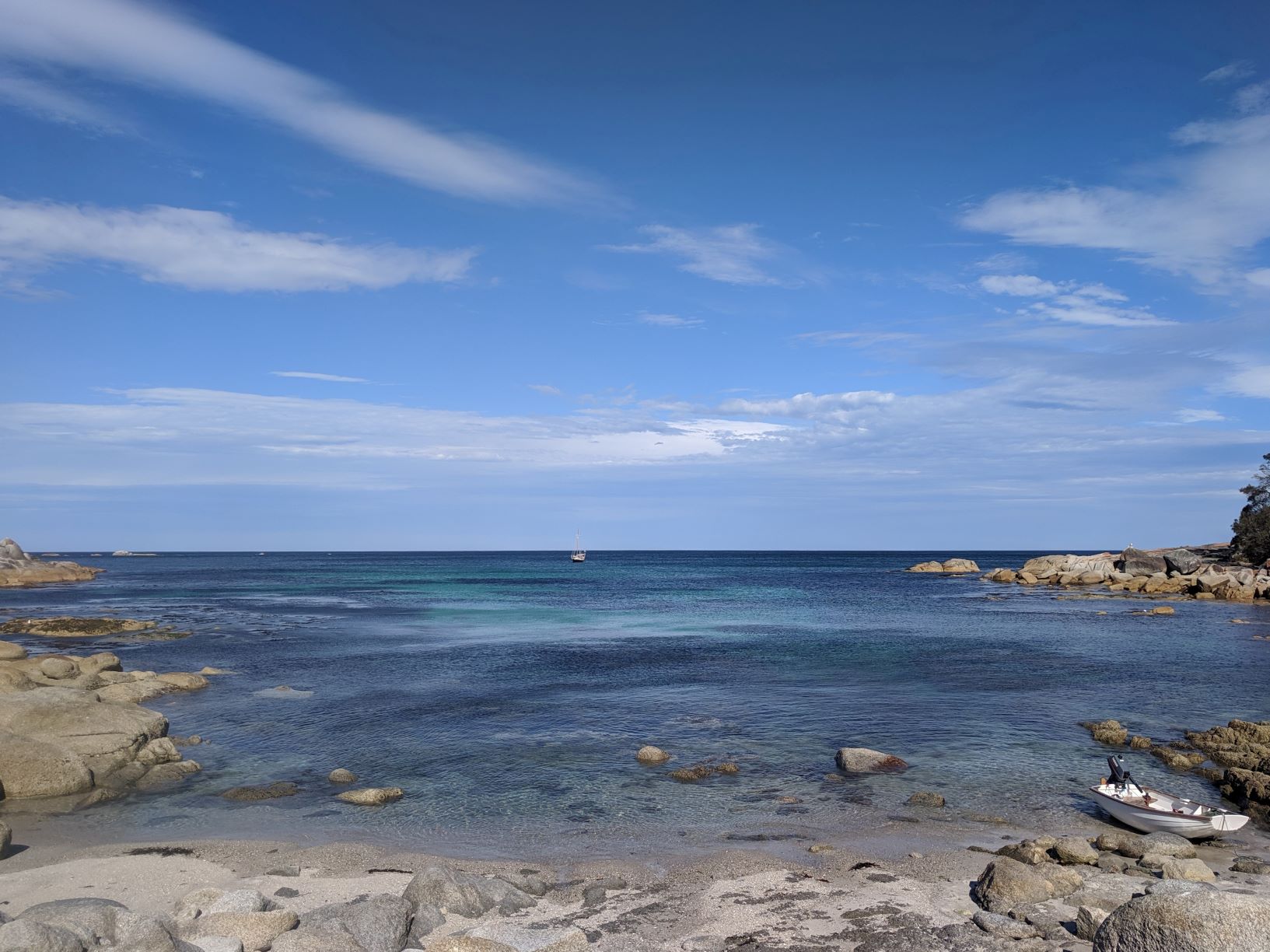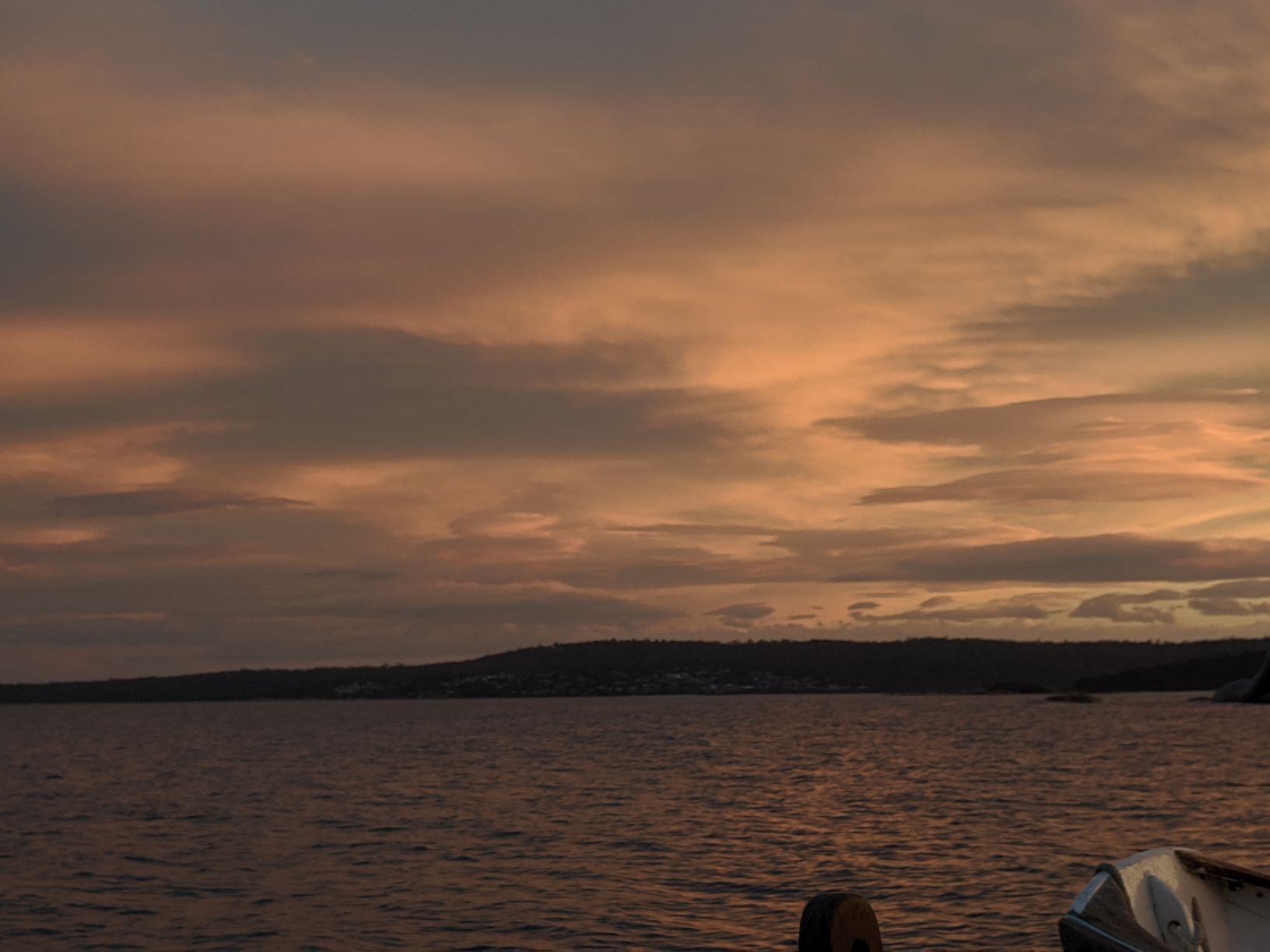November 2019
Leaving Lady Barron we decided to take the eastern entrance out of Franklin Sound through the Vansittart Shoals. The day we left we had perfect weather for this manoeuvre,light winds, no swell and we timed it for an incoming tide. However the cruising guide did suggest that this route should only be attempted with genuine local knowledge of the area. In hindsight I can see why knowing the area prior would be a sensible idea and maybe a warning we should heed in the future.
Even though our conditions were perfect leaving through the shoals there was still plenty of breaking waves and white water, making us a little nervous. While Hugo was on the helm navigating I was on lookout using the binoculars to try and find a clear patch of water through the breakers. We had the suggested route in our anchorage guide and a vague sounding map on Navionics but neither could really be heavily relied upon because sandbars are known to move. This meant we had to be on constant alert keeping an eye on the depth sounder while watching the breakers to find the pattern and a channel. Eventually we felt confident we knew our way out and made a run for it roughly following the books suggested route, squeezing through the line of breakers into the open ocean. It was an exhilarating experience and we had made it through without any real issues, both of us agreeing though that we probably wouldn’t take that route again. Following our squeeze through the breakers we left the shoals behind us commencing a slow sail towards our next anchorage.

We had decided to anchor in Jamieson Bay on Cape Barron Island which was only about 25nm from Lady Barron, relatively close by our standards, so for once we weren’t speed or weather stressed. This meant we could sail leisurely at whatever pace we wanted, not stressing whenever the speed dropped below 3kts. It was late afternoon by the time we dropped anchor in Jamieson Bay which that day was very calm and peaceful. Little did we know the following day the bay would show us a completely different face. We knew a small blow was due but what we experienced the next day was winds much stronger then expected. We woke up that day to a relatively mild breeze but throughout the morning the wind increased. It continued increasing to the point that by lunch the wind was somewhere between 40-60kts and even though we were close to shore, meaning minimal fetch, the wind was that strong it was creating nearly meter high wind chop. This made for a very uncomfortable day, but we weren’t the only ones hanging on tight. Overnight two fishing boats had come in also anchoring in the bay and they were bouncing up and down and swinging from side to side just as much as we were. Luckily throughout the day our anchor held only dragging once before resetting 30m back. However if it hadn’t reset it would have been a different story. Our engine really isn’t all that powerful and with the conditions that day we would have struggled to reset the anchor before getting blown out of the bay. If we had continued to drag we would have had to weigh anchor and head out to sea, either running downwind or hoving-to somewhere. Thankfully though everything worked out and by the time we went to bed that evening the wind had abated allowing us to have a peaceful nights sleep.

The following morning we were ready to move on, the storm had passed and had left us a nice 15-20kt breeze from the west, a perfect wind to finally sail towards Tasmania. We set sail after breakfast aiming to anchor off Eddystone Point which was about 35nm away. Crossing Banks Strait without any issues we had a wonderful sail down Tassie’s north east coast and anchored just on sunset. Eddystone Point was another overnight stop, a very picturesque beach which I’d like to go back to when we have more time. But as time was of the essence the next morning we weighed anchor and were off towards St Helens where hopefully we’d be able to do a proper reprovision.
Leaving Eddystone point we had an impromptu man overboard drill when our bright orange dingy sponge got blown overboard. This was a perfect opportunity as we hadn’t retrieved anything overboard while under sail yet. So with less then 10kts of wind manoeuvring was easy and after doing a couple of circles we successfully retrieved the sponge. With our mock man overboard back on board we continued on our way taking in the beautiful views of Tassies east coast and its white sandy beaches. Although about lunch time we had an interesting encounter with one of the local tour boats. We were sailing about a mile off the coast when a large and fast 20 seater tour boat came speeding up to us. When they were a couple of boat lengths away the boat operator started shouting at us, quite aggressively, telling us to turn around and move further offshore. He had thought we were sailing closer to shore where there was a shallow reef. However we knew about the reef and were nowhere near it or intending to get any closer to it. But obviously he didn’t know this and while we appreciated his warning he could have been a bit more polite and not sped off so fast as leave us to deal with his monstrous wake.

During our sail down we had limited phone signal but from what signal we had we decided that going into St Helens wasn’t actually a good option. To get into St Helens we were required to cross a bar which wasn’t an issue that day or the following. But to get out would have been another story as the swell was due to increase which would have caused large breakers over the bar meaning we’d be stuck inside St Helens for longer then we wanted. So we decided instead we would aim for Binalong Bay which was a small holiday town nearby, but the only problem was that it didn’t have any shopping facilities. But we had worked out it was within cycling distance of St Helens, so the new plan was to ride in and buy whatever we could carry back on a bike. However today was really a day for changing plans and as we neared Binalong Bay we realised the swell wasn’t going to give us a comfortable night. So we decided to anchor in a little nook called Seaton Cove about 3mn short of Binalong Bay. Even though this was just an overnight stop we got in well before sunset and we couldn’t resist going ashore and this would be our first step ashore on Tasmanian soil. Seaton Cove was actually the back of a public camp ground which had road access. So we ended up going for a short walk, following the road and then a walking trail to the nearby headland which offered us a nice view of Sloop Rock and the surrounding bay.

The next morning we moved the boat to Binalong Bay anchoring off the main beach area. We had one mission that day which was to obtain groceries. So first we decided to do a reconnaissance mission ashore to see if there was a suitable place to land the bikes. Binalong Bay had quite a nice public boat ramp/ jetty area which would have been the perfect place to bring the bikes ashore later. While ashore we also decided to stretch our legs so we left the dinghy tied to the jetty while we went for a short walk. We ended up sticking to the foreshore, checking out a couple of the beaches and walking trails. From what we’d seen of this town we decided that riding into St Helens wouldn’t be an issue. However when we go back to our dinghy something unexpected happened which meant we didn’t have to go riding that day after all.
Just as we were about to get into our dingy a local gentleman turned up and started talking to us about our boat. The gentleman admired our lifestyle, pleased to see young people out sailing. He told us how he’d been an avid sailor in his younger years mostly involved in offshore racing but with age he had to give it up. After chatting for about half an hour we were about to say farewell when Hugo asked about the road conditions between Binalong Bay and St Helens for cycling. The old sailor said the road was well maintained but then did something a little unexpected by kindly offering us a lift into St Helens, which we gratefully accepted. The drive into St Helens only took about 10 minutes by car but if we’d ridden it would have been closer to 30 minutes as there were a few hilly sections. St Helens was a reasonable sized town with a major IGA, a perfect place to get everything we needed all in one place. So once inside we quickly made the rounds of the supermarket, zipping down each isle and buying a small trolley load worth of supplies, much more then what we would have fitted on two bikes.
That afternoon when we arrived back on Allagai we stashed our supplies and for the first time in many weeks we breathed a sigh of relief. Our last resupply it had been 6 weeks ago and although we still had plenty of rice, pasta, oats, flour and other similar dry stores we were starting to get creative with our meals running low on fresh food (meat, vegetables and fruit), milk and canned items. We had estimated that we probably had only about two weeks of food left. With this resupply though we were no longer stressed about food as we now had about a months worth of supplies and would be within reach of a shop well before running out this time. So with that in mind we decided we’d set off the next morning for Wineglass Bay with the intention to actually explore the place and not just pass through.
